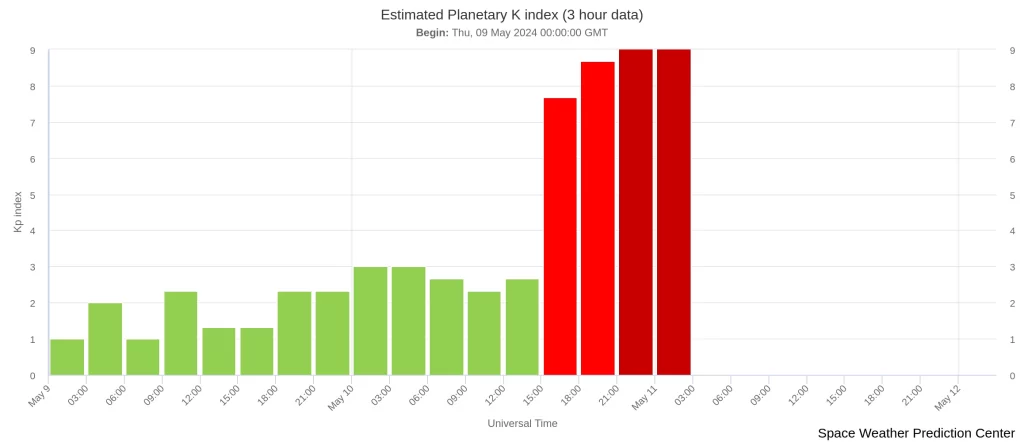The first set of several incoming coronal mass ejections (CMEs) impacted Earth at around 16:56 UTC on May 10, 2024, rapidly increasing geomagnetic field levels from unsettled to G4 – Severe by 17:44 and to G5 – Extreme by 23:34 UTC — something we haven’t seen since 2003.
A strong CME was registered in solar wind data beginning at around 16:35 UTC and reached Earth at 16:56 UTC, with a 108 nT deviation measured at the Boulder magnetometer. Following initial shock arrival, total field strength increased to a peak of 55 nT while Bz was sustained southward, by as much as -47 nT, after 16:45 UTC.
Solar wind speeds increased sharply to around 700 km/s following shock arrival, with a peak value of 741 km/s observed at 17:35 UTC. Conditions further enhanced later, with Bt reaching 74 nT, Bz deviating southward to near -50 nT, and solar winds peaking over 800 km/s.
The geomagnetic field rapidly increased from unsettled levels to G4, and eventually G5 – Severe geomagnetic storm levels following the CME arrival.



Aurora sightings were widespread in both hemispheres, reaching as far south as Florida, U.S., and the Mediterranean Sea in Europe.
One of the first amazing images came out of New Zealand and Tasmania, described as ‘absolutely biblical.’
The last time Earth had a G5 – Extreme geomagnetic storm was in October 2003, resulting in power outages in Sweden and damaged transformers in South Africa.
Here’s a selection of some of the sightings across the world:
Absolutely biblical skies in Tasmania at 4am this morning. I’m leaving today and knew I could not pass up this opportunity for such a large solar storm. Here’s the image. I actually had to de-saturate the colours. Clouds glowing red. Insane. Shot on Nikon. Rt appreciated pic.twitter.com/210hlkmoeg
— Sean O’ Riordan (@seanorphoto) May 10, 2024
Um. So. Guys. This is my yard in FLORIDA… #flwx #aurora pic.twitter.com/TX4JtcfsYr
— Logan Parham (@StormChaserLo) May 11, 2024
I had one of the most amazing experiences today seeing the #Aurora in Sanilac County Michigan. Here are my pictures. #NorthernLights #MIwx pic.twitter.com/GC8U65VCSB
— Stephen Szulborski (@Stebo_Wx) May 11, 2024
Nature’s symphony painted the skies tonight!
Witnessed the strongest aurora in two decades from Switzerland’s Jungfraujoch.
A breathtaking reminder of the magic in our universe. #Aurora #Auroraborealis #Nothernlights#Jungfraujoch #Switzerland
— Mr. Shaz (@Wh_So_Serious) May 10, 2024
More #Aurora pic.twitter.com/AM4NVay5af
— Dr Andrew Dickson reform/ACC (@AndrewDickson13) May 10, 2024
What is even happening right now? I feel like I am having a religious experience – or an alien abduction. Not sure which. #aurora pic.twitter.com/vgDUP0YUC9
— Dr David Boyce (@DrDavidBoyce) May 10, 2024
Incredible, Mind-blowing live visuals of the Night sky in majority of Europe right now!
Poland, Germany, Ukraine, Switzerland, Netherlands, Spain, France are witnessing Northern Lights/Aurora in sky thanks to ongoing Solar Storm!#solarstorm #aurora pic.twitter.com/e57Dcxi9zo
— Vishal Verma (@VishalVerma_9) May 10, 2024
Aizvadītā nakts bija visskaistākā, ko esmu redzējis. Veicu krāsas uzlabojumus ziemeļblāzmas fotogrāfijām. Visas šīs fotogrāfijas ir uzņemtas ar telefonu!@StarSpaceLV @MeteoLatvia @boms_tricis#ziemeļblāzma #northernlights #aurora pic.twitter.com/QblFjC5WDM
— Linards Dedzi (@LinardsWeather) May 11, 2024
It’s likely this geomagnetic storm was caused by a Cannibal CME — when fast-moving CMEs overtake slower CMEs in front of them and merge into one. Forecast models suggest three of them merged into one yesterday. If so, we still have at least 3 more CMEs coming our way.
Solar researchers believe cannibal CMEs may be the source of ‘complex ejecta’ CME clouds; those with a larger and more complex structure than typical CMEs. These traits cause complex ejecta CMEs to trigger protracted magnetic storms when they envelop the Earth, according to NOAA.


According to SWPC forecasters, periods of G3 – Strong to G5 -Severe geomagnetic storms are expected on May 11 due to continued CME activity.
Periods of G1 – Minor to G2 – Moderate storming are likely on May 12 due to the anticipated arrival of at least two more halo CMEs associated with activity from Region 3664 on May 9 and 10, in addition to the onset of coronal hole high speed stream (CH HSS) influences.
Unsettled and active conditions are expected on May 12 due to waning CME influences and continued CH HSS influences.
For more information about increased solar activity over the past few days, visit:
You can follow space weather in near-real-time at SWX and follow us on X where we post all C+ solar flares and SWPC Alerts, Watches and Warnings.
Featured image credit: Dr. Andew Dickson
Major X3.9 solar flare erupts from AR 3664 — the 10th X-class flare in just 7 days
Friday, May 10, 2024
G4 – Severe or greater geomagnetic storm forecast as multiple CMEs merge and impact Earth on May 11
Thursday, May 9, 2024
Long-duration X1.0 solar flare erupts from geoeffective Region 3664, CME impact expected on May 11
Wednesday, May 8, 2024
Giant hailstones destroy over 15 000 homes in Manipur, India
Tuesday, May 7, 2024
Large tornado rips through Barnsdall, Oklahoma, causing massive damage and casualties
Tuesday, May 7, 2024
Historic floods hit Porto Alegre, Rio Grande do Sul, Brazil
Monday, May 6, 2024
Major X4.5 solar flare erupts from Region 3663 — fourth X-class flare in 3 days
Monday, May 6, 2024